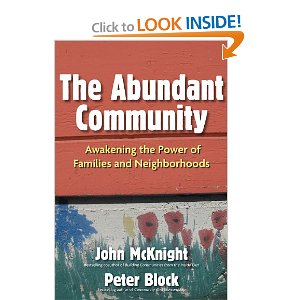 A friend of mine works at city hall in my hometown of Elgin, Illinois. A few months ago, I found myself in her office explaining a series of blog posts calling the city’s Nightmare on Chicago Street event into question for its use of non-profit organizations to sell tickets and staff the event with non-profit volunteers. After a great meeting where I explained myself (and I think we found ourselves on the same page), this friend decided to play Oprah and loaned me a book titled “The Abundant Community: Awakening the Power of Families and Neighborhoods” by John McKnight and Peter Block. After reading the book, I find myself asking:
A friend of mine works at city hall in my hometown of Elgin, Illinois. A few months ago, I found myself in her office explaining a series of blog posts calling the city’s Nightmare on Chicago Street event into question for its use of non-profit organizations to sell tickets and staff the event with non-profit volunteers. After a great meeting where I explained myself (and I think we found ourselves on the same page), this friend decided to play Oprah and loaned me a book titled “The Abundant Community: Awakening the Power of Families and Neighborhoods” by John McKnight and Peter Block. After reading the book, I find myself asking:
Do non-profit organizations do more to hurt our communities than help?
Well, ain’t that a kick in the pants? LOL I was all excited to read this book because it is an urban planning textbook about neighborhood planning and engagement, and I have two degrees in urban planning. I really thought this book would be a fun walk down memory lane. Instead, it called my entire career path in non-profit management into question.
 In a nutshell, the thesis of the book is that we’ve moved from a citizen and neighborhood based society to a consumer-based one. In the citizen-based society, people lived and thrived within their neighborhoods. Everything they needed (e.g. safety, jobs, food, family, care, etc) could be found in their neighborhood. Today, our consumer-based world has us looking for all of these things outside of our neighborhoods, which in effect results in us surrendering to others “… the power to provide what is essential for a full and satisfied life”.
In a nutshell, the thesis of the book is that we’ve moved from a citizen and neighborhood based society to a consumer-based one. In the citizen-based society, people lived and thrived within their neighborhoods. Everything they needed (e.g. safety, jobs, food, family, care, etc) could be found in their neighborhood. Today, our consumer-based world has us looking for all of these things outside of our neighborhoods, which in effect results in us surrendering to others “… the power to provide what is essential for a full and satisfied life”.
While this is something that is very theoretical, I find the implication of these ideas to be revolutionary in nature. After all, how many times do you hear things like:
- citizenship, empowerment and engagement can be undermined by corporations, government and professional & academic institutions,
- the social cost of “consumerism” is that it contributes to families losing their function, and
- the marketplace cannot solve our problems.
The book calls out the non-profit sector as part of the consumer-based world and one of the institutions that undermines our sense of neighborhoods and citizenship. Check out this passage from the book:
“In the consumer ecology, the word care has been co-opted by systems: business, agencies, and governments … Our charities ask us to give money to pay for the care of people. … In each case, they are actually providing a paid service — not care. This is a key distinction, the difference between care and service. Systems offer services for pay; they offer actuarial, medical, and administrative services. We know it is not care, because genuine care cannot be paid for. It is given, free of charge.”
That last passage got me thinking. Do non-profit organizations really try to “replace” families and neighborhoods. Or do they just try to patch the holes in a safety net for people who don’t have strong families and neighborhoods on which to rely? And then I read this passage in the book:
“In the system world of philanthropy, generosity is sometimes called “charity,” which is really an unstable and false generosity because it is oriented around the needs and deficiencies of just one party in the transaction. Charity is demeaning in this way. As if you need me, and you have nothing but gratitude to offer in return. Charity says, “You have not earned this; I am giving it to you because you have so few gifts.”
 Whoa! This last passage from the book really upset me, but then I stopped and thought about it for two seconds. There is truth in those words, especially for many non-profits who practice a form of “tin cup” fundraising.
Whoa! This last passage from the book really upset me, but then I stopped and thought about it for two seconds. There is truth in those words, especially for many non-profits who practice a form of “tin cup” fundraising.
At this point, I think I was beside myself and wondering if my career path choices have contributed to the erosion of our sense of community and citizenship. So, rather than find a tall building to jump from, I decided to focus on the few positives that non-profits should take from this book:
- Focus your fundraising and philanthropic efforts on building something (e.g. return on investment) rather than “charity” and “tin cup” appeals.
- Invest in relationship building and using your agency as a vehicle for connecting people and building a sense of neighborhood and community.
- Offer programming that teaches people to “do for themselves” and stop doing it for them.
- Create philanthropic opportunities that go beyond just donating money and allows people to donate things/stuff, time and talents.
I appreciate that today’s post was very theoretical, but it certainly does give any free thinking non-profit person cause for pause. Right?
What are your thoughts on the book that my friend from city hall loaned me? Did you find any truth in it? How does your agency build relationships between people and institutions? How do you guard against practicing tin cup philanthropy? Do you know how your fundraising volunteers are framing your case for support with donors, and are you sure it isn’t tin cup philanthropy?
OK . . . I need someone to talk me down off the ledge.
Here’s to your health!
Erik Anderson
Founder & President, The Healthy Non-Profit LLC
www.thehealthynonprofit.com
erik@thehealthynonprofit.com
http://twitter.com/#!/eanderson847
http://www.facebook.com/eanderson847
http://www.linkedin.com/in/erikanderson847

I’ve just started a blog series on our website about non-profit competition. Here’s the first installation. http://cooperhong.com/blog/2012/02/when-competition-is-fierce-competing-for-attention-part-1
Loved your blog and think there’s tons of merit in the issues you raise.
Thanks, Christopher. Good luck with you blog series. Please don’t be a stranger and consider subscribing if you already haven’t done so.
~Erik
Hi Erik,
I loved this post and definitely see a lot of truth in it. Thankfully, I work at a non-profit that connects local volunteers with issues in the community that they’re passionate about. My program specifically encourages relationships between our volunteers and the students that they help.
All of that said, when we begin focusing on fundraising and finding donors, this blog post will be great to reference back to. Thanks for posting it!
You are welcome! If you’re ever in a position to hire a fundraising consultant sometime in the future, please keep me in mind. 😉 You can find more info on my services at https://www.thehealthynonprofit.com.
Good luck with you endeavors. Please consider subscribing to the DonorDreams blog if you already haven’t done so. The more the merrier! Also, I offer a free month e-newsletter over at The Healthy Non-Profit website. It might be something you want to consider. It is FREE. LOL 😉
Thanks for your kind words and comment!
~Erik